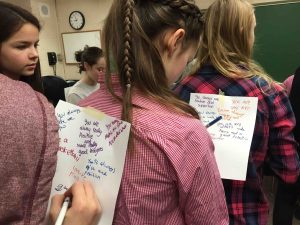Jun 15, 2017 Showing Appreciation and Celebrating Success
This time of year as I work with school programs to wrap up the year and facilitate final faculty professional development days, the idea of celebrating success and honoring the contributions of others seems especially important. Below is an excerpt from Tips & Tools for the Art of Experiential Group Facilitation that focuses on the value of and practical suggestions for include opportunities for celebration in your programs.
Create Opportunities for Celebration and Appreciations!
This is a critical part of creating and maintaining a positive environment where participants feel they can take healthy risks, be supported, and leave with some positive growth and success experiences. Unfortunately, in many work and traditional educational settings, time is not regularly taken to show appreciation for achievements. People often only get feedback about mistakes or misbehavior.
As a result, participants may be awkward with celebrating and giving and receiving feedback. Many people, especially in school and treatment settings, seem to have a difficult time giving and receiving meaningful appreciation and naming their own strengths and positive achievements. They don’t seem to get much practice articulating their thoughts, feelings, and reactions, much less giving and receiving feedback with peers.
 Facilitators can help create an atmosphere in which group members can comfortably show appreciation for each other and celebrate success by role-modeling a generous spirit toward self and others and intentionally weaving in celebratory gestures and activities from the very beginning. Your excitement and attitude can be contagious, so during competitive activities show appreciation and support toward all of the participants. As the group progresses, celebrating success becomes automatic, and participants intuitively make an effort to show sincere appreciation when peers move outside their comfort zones. These celebrations create an empowering atmosphere. The practice of acknowledging and celebrating success and positive moments will likely transfer back to the classroom, workplace, or family.
Facilitators can help create an atmosphere in which group members can comfortably show appreciation for each other and celebrate success by role-modeling a generous spirit toward self and others and intentionally weaving in celebratory gestures and activities from the very beginning. Your excitement and attitude can be contagious, so during competitive activities show appreciation and support toward all of the participants. As the group progresses, celebrating success becomes automatic, and participants intuitively make an effort to show sincere appreciation when peers move outside their comfort zones. These celebrations create an empowering atmosphere. The practice of acknowledging and celebrating success and positive moments will likely transfer back to the classroom, workplace, or family.
In my June 2015 blog post I shared one of my favorite group celebration activities used for intentionally focusing on appreciations, celebrating strengths, and building and reinforcing positive group norms with longer-term groups “Peek-A-Who Celebrations.”
Here is another favorite that is a nice follow up to that activity:
Appreciations Notes:
Use this activity with long-term groups to engage participants in showing appreciations and giving feedback in a fun, non-threatening way. It works best with those who know each other well and need some self-esteem boosters and opportunities to celebrate each others’ strengths.
Materials: a piece of paper and thin washable marker for each person, masking tape
Facilitation Suggestions
• Tape a piece of paper on each participant’s back (asking permission first, of course), and give everyone a marker.
• Invite participants to visit everyone in the group and write a thoughtful appreciation or positive feedback on his or her piece of paper. Explain that the focus is on personality strengths or positive actions rather than physical characteristics. For school-age groups, give clear examples of appropriate compliments: “I appreciate your willingness to speak out when you have concern.” “You are very observant.” “You make a great leader.”
• After everyone is finished, give participants the opportunity to sit down and read through their lists.
• Invite participants to form a circle and share at least one of their positive notes.
Facilitation Note
With clear directions and parameters set at the start, most groups will readily engage and participate in a positive way. I have found that this activity has been especially effective with adolescents who may lack self-esteem and don’t give and receive positives very often. I often scaffold this activity with “Peek-a-Who Appreciations to give participants practice with using positive descriptive language. I find the final act of inviting participants to read aloud at least one positive note about themselves is the most powerful part of this activity. Most choose to read more.



No Comments